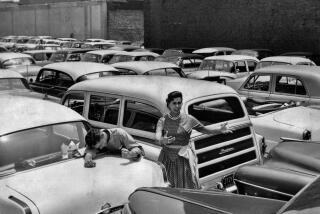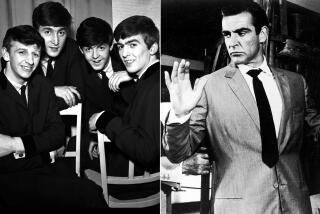Tales of the city
- Share via
HOW is it that British cities went from being dirty, overcrowded eyesores swollen by the Industrial Revolution to splendidly burnished repositories of civic institutions and humane social services -- only to fall into dismal neglect in the 20th century, from which they are only now beginning to emerge? Tristram Hunt tells this complex, epic story with dazzling clarity and organizational brilliance in “Building Jerusalem: The Rise and Fall of the Victorian City.”
Hunt teaches modern British history at the University of London, writes regularly for periodicals and appears often on television. His high-journalistic writing style, while blessedly lucid, sometimes falls into the overly perky manner of academics trying too hard to woo a popular audience. Glibness aside, this book is a triumph of scholarship, sound judgment and synthesizing skill. I know of nothing equaling its scope and ambition in American urban studies, and the relevance of the British experience to our own cities shines forth on every page.
The author combines the physical and intellectual records, reanimating long-buried debates about aesthetics and local governance. The squalor of the mid-19th century city of Queen Victoria’s day comes alive in testimony by physicians and clergymen. William Blake’s poetic characterization of industrial urban England as “dark, satanic mills” is cited along with Dickens’ description of Coketown in “Hard Times.” There are also cogent summaries of commentary (mostly very negative) about contemporary cities by such esteemed thinkers as Thomas Carlyle, John Ruskin, William Morris and Thomas Babington Macaulay. All this high-minded criticism prepared the ground for the astonishing transformations of Manchester, Birmingham, Glasgow, Liverpool, Bradford, Leeds and London.
Although no book about the Victorian-era city can afford to overlook London, and the author gives the capital its due, he writes with more enthusiasm about the others. Perhaps it is because London already has been studied so much, but also because he is keen on showing how the decentralized metropolises of the north, which did not receive national subsidies, nevertheless pulled themselves up by their bootstraps; built magnificent town halls, libraries, museums, hospitals and piers; provided cheap gas, clean water, modern sanitation, sewage and affordable housing; and tinkered effectively with street patterns. His heroes are such business leaders as Birmingham’s Joseph Chamberlain, who worked first within volunteer societies and later through town councils to improve their cities.
Hunt’s thesis, or agenda, if you will, is that what he calls “the great middle class” played a historic role in developing Victorian-era cities, investing their energies in civic activism because cities were places of freedom, tolerance and sympathy for industrious strivers. (No doubt he is also trying to rehabilitate the middle class from the Thatcher years, when it was perceived as a selfish, privatizing force.) He also credits such dissenting religious sects as the Methodists and Congregationalists with a large share in creating the urban improvements.
English manufacturers and merchants -- prosperous but insecure, vulnerable to charges of mammonism and philistinism -- were much given to emulating their continental neighbors. First the Gothic Revival reigned, influenced by Walter Scott’s chivalric novels and neo-Gothic architect and reformer A.W.N. Pugin’s tirades, and it was even argued that this ecclesiastically tinged medieval style was the proper patriotic English expression for great national buildings. Then the Italian Renaissance had its day, thanks in part to Ruskin’s writings on Venetian style and the Medicis’ Florence. British visitors were awed by Baron Georges-Eugene Haussmann’s overhauling of Paris with stately boulevards and sought to import those beaux-arts configurations. Finally, Hellenic influence began to be seen in neoclassical architecture.
Beyond the Victorian fashion for all things Greek, Hunt argues, there was the tempting model of the city republic. “The city republics of classical Greece had combined the civic ideals of the urban middle class: local self-government, internal liberty, a culture of rationalism and, crucially for civic identity, the combination of commercial success with aesthetic vibrancy.”
In Glasgow, the workers took charge of the town council, trying to realize the equivalent of socialism in one city. Bakeries, bathhouses, urban transport, utilities, education, medical assistance, hospitals, police, food and clothing, were all brought under municipal sway. Throughout Britain, between 1884 and 1914, municipalities’ annual expenditure on gas, water, electricity and tramways quintupled, which reflected only part of their burgeoning investment. Eventually, parts of the citizenry objected strenuously to increased taxes, and the process of civic transformation was put on hold; then began the long retreat, the pattern of de-investing in the cities.
It should be instructive for Americans, who think with masochistic pride that we invented urbicide, to see that the British made the same errors as the 20th century advanced: They destroyed beautiful public buildings, encouraged the unchecked growth of suburbs through construction of highways and new towns while sapping the tax base of the cities, razed working-class neighborhoods for ill-conceived “urban renewal” schemes and stripped decision-making power from mayors and local councils, putting it in the hands of centralized government. British planners were as seduced as ours by Ebenezer Howard’s “garden cities” and Modernist architect Le Corbusier’s unholy “towers in the park” approach.
These misguided interventions, along with the collapse of such stable industries as shipbuilding, coal, textiles, iron and steel, which had been sustaining northern cities, resulted in bleak, dangerous inner cities filled with unemployed workers. Only in the last 15 years have these northern cities begun to come back, nurtured by cultural expositions, historical preservations and other modest amenities.
Hunt is invariably sympathetic to more enlightened urban notions, which promote vitality, diversity, density and street life, and which we associate with urban critic Jane Jacobs. For the author, though, it is not just a question of following the proper principles of urban design but of promoting citizenship and democracy. “The fundamental question comes down to one of identity: how do you re-engage a notion of civic patriotism or civic pride with an individualistic society with only the loosest of affiliations to nation, region and class, let alone to the city? The achievements of the Victorian municipal leaders were often premised upon a popular level of civic identification, which began to wane from the early 1900s. To identify with the city demands not only employment ties and physical location, but a sense of pride in the achievement and image of the polis.”
Some have said that the great era of urban civilization is already over, as globalization makes every place look alike, suburban sprawl eradicates the distinction between urban and rustic, and we are left with “museum cities” like Florence or cartooned simulacra of famous metropolises, as found in Disney World and Las Vegas. Nonsense, Hunt seems to say here: All we need to do is roll up our sleeves and pursue correct urban policies again. Do like the Victorians.
More to Read
Sign up for our Book Club newsletter
Get the latest news, events and more from the Los Angeles Times Book Club, and help us get L.A. reading and talking.
You may occasionally receive promotional content from the Los Angeles Times.








